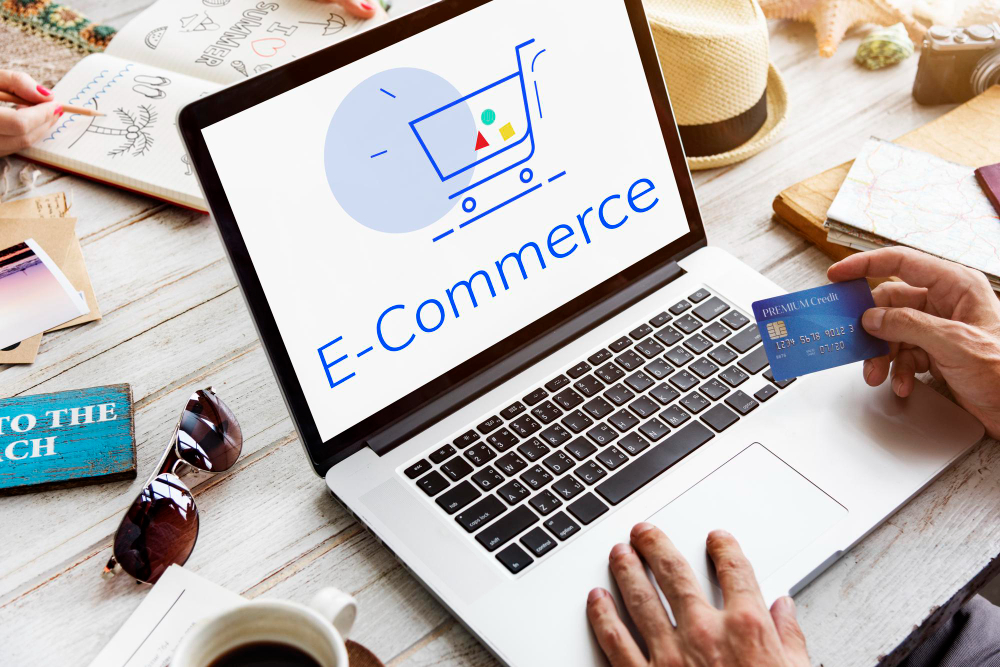What is more stressful than launching an eCommerce store? The idea of not developing it while your rivals continue to expand globally. Yes, you might need to scratch your brain daily, scheming to catch pace with your competition, but every endeavor is worthwhile.
From finalizing the website’s product catalog by selecting the design, layout, from optimizing the SEO to promoting your brand, e-commerce website creation entails a great deal. However, nothing is possible unless you truly resolve to get out of your comfort zone and step into e-commerce application development.
Today, we’re bringing you an optimal e-commerce website building guide in which we’ll cover every component needed for the development of a profitable e-commerce store.
Also, read – 6 Mistakes to Avoid While Hiring An Ecommerce Web Development Company
E-commerce Market Analysis and Statistics
E-ommerce has transformed the way business is conducted in India. By 2026, the Indian e-commerce industry is expected to reach $250 billion, up from$ 36 billion in 2017. Furthermore, an increase in internet and mobile phone adoption can be seen as a significant catalyst for the industry’s growth.
The country’s ongoing digital transformation is expected to boost India’s entire internet user base to 865 million by the end of 2021, up from 603 million in FY19. Although, this is the case in India; however, e-commerce is expanding globally as well.
Even with minimal cash, business entrepreneurs nowadays find it quite simple to establish a firm. Buyers are increasingly depending on buying online; in fact, studies indicate that by 2040, online sales would account for 95% of all purchases. Round-the-clock accessibility is the primary key to digital shopping’s success.
Types of E-Commerce Websites
1. Business to Business E-Commerce Websites
B2B websites are those where businesses sell goods and services to one another over an online sales platform. Generally, it is utilized to increase the efficacy and profitability of a company’s sales activities. For example, a machine manufacturer sells customized cutting tool equipment to a woodworking shop.
Alibaba.com is a well-known example of a business-to-business (B2B) online trading hub where various merchants offer their products. If your firm provides B2B services, you should hire a company that specializes in B2B e-commerce website development services.
2. Business-to-Customer E-Commerce Websites
B2C websites are those that facilitate e-commerce transactions between businesses and consumers. An e-commerce website provides users with a comparison shopping experience to that found in brick-and-mortar businesses, but through the use of an online catalog, the ability to choose products for purchase, and the ability to check out digitally.
Amazon, Flipkart, etc. Are all specialized eCommerce platforms wherein various companies offer their products and services for sale to the general public.
3. Customer-to-Customer E-Commerce Websites
C2C e-commerce refers to platforms where one person offers goods and services to another customer entirely online. For instance, eBay and Etsy operate similarly to C2C e-commerce platforms. Typically, this sale is handled through a third-party website that assists in managing the specifics of the transaction, commonly referred to as a marketplace.
4. Consumer-to-Business E-Commerce Websites
Another amazing approach, the C2B revenue model is well-known due to the platforms that connect freelancers. This is where freelancers execute client-provided tasks. The majority of these clients are business organizations, whereas the freelancers are often individuals. To put it simply, we regard C2B as a single owner that provides services to larger enterprises.
Skills To Look For In A Professional E-Commerce Website Developer
Web Designing Skills
When developing or rebuilding an e-commerce website, a skilled web developer must be able to identify the website’s fundamental components, including navigation, layout, space, color, and contrast. These components should be combined in unison to provide an outcome that engages and converts clients. If done correctly, you’ll have an attractive website, regardless of how simplistic the design is.
Effective Communication Capabilities
Typically, the first person with whom you will work is a web designer. When evaluating the project, a designer must be an effective communicator and listener. Web development may go into the most intricate technological details, which can be quite a struggle if you are not particularly tech-savvy. Hence the developer should be able to communicate every detail to you in simple language.
Capability for Problem-Solving
Although you might have had an absolutely flawless, crystal clear dialogue with the developer, imperfection is unavoidable. A web designer has to painstakingly fine-tune the design as necessary. The website may undergo technical difficulties along the road, including challenges with functioning, navigation, administration, or integration. A skilled developer must be able to identify the core problem from a variety of perspectives and should propose alternative development solutions.
Updated With Cutting-Edge Web Technology
As with technologies, e-commerce web design concepts appear and disappear. A competent e-commerce web developer should be knowledgeable about the ins and outs of website designing. They can accomplish this by:
- Subscribing to reputable sources such as web development blogs and RSS feeds
- Take a look at the most recent industry news.
- Accept the fact that they do not know all and there is always more to learn.
Expertise in Front-End Languages
HTML, JavaScript, and CSS are the web programming technologies that a website developer works with. Developers need to acquire an extensive grasp of these languages to determine which features are possible and which are not. This is to prevent design errors that might result in a delayed launch.
Proficiency with PHP and MySQL
PHP and MySQL are perhaps the most widely utilized web development technologies available today. The former is used to create dynamic websites, while the latter is used to manage database material. Possessing expertise in both enables a developer to construct nearly any type of website – from a simple contact form to a large corporate portal.
Expertise in E-commerce
Creating informative websites is a very different process than creating e-commerce business websites. Along the way, there are several business choices to be taken. Which payment gateway does the client tend to favor? Is he more comfortable paying with a credit card or COD? Do you require the installation of additional third-party applications? An open-source development company or e-commerce developer must be aware of these scenarios to ensure a streamlined development process.
E-commerce Website Development Checklist
Website development eCommerce – establishing an e-commerce business is a demanding task. Many tasks take your commitment, and success remains elusive. This ambiguity, however, is no reason to avoid launching an e-commerce store.
To assist entrepreneurs in planning their first venture into the turbulent seas of e-commerce, the following is a checklist that includes all critical aspects of establishing and operating an e-commerce store.
1. Design and Layout of a Website
By now, it should be apparent that an e-commerce site has fewer than five seconds to capture a visitor’s attention. The layout and store design are critical components of this issue. Two straightforward suggestions in this situation are as follows:
-
Improve User Interfaces
The appearance of your store is the primary point of contact between you and potential consumers. To be effective, you need to have a style that is uncomplicated, vibrant, and unobtrusive.
Jet.com is an excellent example of superb design. The most popular goods are displayed first, backed by discounts and special offers. A user who visits the homepage will immediately see which goods are on sale.
-
Create a Flowing User Interface
The great news is that, apart from a few fundamental principles, there’s very little that prevents you from developing visually appealing and innovative user interfaces and shop layouts. This means you may either include a banner at the top or simply showcase square boxes to represent store categories. All is up to you!
2. Content Optimization
Without proper optimization, your e-commerce firm will have a difficult time rising to the top of the Search Results. Optimizing the storefront can be split into two fundamental components:
- Create Captivating Content
E-commerce is mostly about creating visually appealing content that engages your audience. Infographics and the visuals capture a customer’s attention quickly.
- Organic Search Optimization
After creating the pages, the next strategy is to optimize them for better search engine results ranks. This often entails altering the content’s layout, adding keyword phrases, and supplementing the pages with relevant visual components such as photos, videos, and infographics.
3. Product Description Pages
A significant amount of visitors arrives on product detail pages, which is where the action occurs. You must tread carefully in the following 2 domains that affect the effectiveness of these pages:
- Enhance Item Display
Commerce, and specific e-commerce, has a golden phrase: ‘if it shines, it sells’. E-commerce shops ARE REQUIRED to prominently showcase items with attractive graphics and well-written descriptions. Try including a price-time chart that displays the price of the item at a certain moment to assist visitors in making rational choices.
Secondly, the majority of big online retailers, like Best Buy, and Newegg, now include a price comparison tool on their product sites, indicating that their price is the cheapest.
- Visuals Aid in Product Sales
E-commerce website designers can enhance the product page’s appeal by including many pictures of the product. Furthermore, video introduction reviews, lend credibility to the goods and assist the visitor in choosing a product.
4. Checkout Process
As per various studies, over 30% of users abandon a checkout procedure due to its complication or latency. According to another study conducted by Kissmetrics, the payment process should be seamless and should not urge the customer to sign up when checking out.
- Make Checkout Easier
The checkout procedure should not take more than three steps from beginning to end. Account creation can occur after the transaction and should not be a necessary step of the transaction.
- Add Giveaways to Your Shopping Cart
Offering consumer gifts is an effective approach to entice them to click ‘purchase’ rather than the return button. For example, a $10 OFF coupon can help visitors recall your store and boost the number of repeat consumers.
5. Support Pages
Many e-commerce business owners are unaware of the critical role that support pages play in the overall administration of an e-commerce company. For several customers, these pages serve as their initial source of information on store refund policies and other vital information. Whenever it comes to help pages, experts recommend:
- Maintain Simplicity
The privacy statement, exchange policy, and refund should all include specific information about the procedure. You should ensure that the guidelines are simple to read and understand so that customers do not require assistance from the help desk. On these pages, key points must be highlighted via bullets.
6. Integrating New Technologies
Numerous entrepreneurs are oblivious of the increasing effect of technology advancements such as voice controls and VR technology. An e-commerce store’s design should incorporate these new technologies as a central component.
- Create a Mobile Application
Being an e-commerce store owner, your goal should be to find a reliable and experienced mobile app development company, which can help you in developing a platform-optimized mobile application that offers a seamless user experience.
- Emphasize on Voice Search
According to Google, 37% of the worldwide population now use voice search to do internet searches. It is simply unavoidable. This means that improving your store for voice control should be a significant part of your SEO strategy.
7. Analysis and Tracking Capabilities
Many business owners disregard statistics and monitoring of store data merely because the subject appears to be unrelated to the store’s business activities. However, these efforts generate essential data for developing strategies.
- Utilize Web Analytics Software
Tracking tools are the most effective method of determining the store’s success. The tracking tools can monitor traffic, user activity within the store, and the user’s time spent online. Google Search Console can collect a variety of information daily, along with the proportion of page hits.
Cost of E-commerce Website Development
eCommerce website development cost – regardless of the type of website you wish to develop – ranging from a feature-rich e-commerce storefront to a simple WordPress site – there are two critical expense categories:
- Functionality and Design – That’s what customers see when they visit your site, interact with your product, and make a purchase.
- Infrastructure – These are the various costs connected with the building and running of an e-commerce website that may be invisible to your audience. For instance, acquiring a domain, configuring servers, and optimizing your website’s SEO.
As we break down the ecommerce website cost, you’ll discover that there is not any fixed amount for the e-commerce website developer. However, the estimated cost can be calculated considering the following elements:
- Domain Name
- Hosting
- Custom Design
- Web Development
- SEO and Marketing
- Domain Name
You cannot have a website without a domain name. This is the registered address for your e-commerce site, therefore it’s essential to choose wisely. In general, domain names cost between $5 and $20 through registrars like Namecheap or GoDaddy.
- Hosting
The hosting service serves as the foundation for your online business. It is critical to make your services accessible to customers 24×7 by investing in a reliable hosting provider. You have two basic options:
- Independently host your e-commerce website.
- Make use of an e-commerce platform like Shopify.
Pricing varies per business and plan, but you can get a plan between $10 and $25 per month for independent hosting. Shopify hosting plans starts at $29 and go up to $399.
- Personalized Web Design
If you want to give your e-commerce website a unique and attractive look, custom ecommerce web design services are an excellent option. Tailored to your business, market, region, and requirements, these services ensure that the final design meets all of your expectations.
The cost may vary depending on the scope and complexity of the work, but you can anticipate a cost between $500 and $5,000. Furthermore, if you need an enterprise-level design with an infinite amount of internal pages – such as those goods or categories – the cost would almost certainly exceed $5,000 to $50,000.
- Web Development
The distinction between development and design is a subtle one. The term “design” refers to the website’s physical layout. It’s the first thing people see when they arrive at your online store. However, development entails several services and support, some of which function in the background to keep your website running.
If you’re hiring e-commerce developers or a web development company, ensure they have significant experience with e-commerce websites. Rates vary based on experience, platform, scope of work, and location. At the low end, you may be required to pay between $5 and $20 per hour.
Search Engine Optimization and Marketing
You may create the finest e-commerce website in the world, but without visitors, it is nothing. You need people to visit your website, interact with your business, and share their positive experiences with others. That is where marketing and SEO come into play.
It’s one of those categories that’s difficult to price. But, you can always hire a digital marketing firm that will assist you in boosting your e-commerce store. The estimated expense will be around $100-$200 per month.
Conclusion
Setting up an e-commerce business in 2021 is not difficult, but unlike the previous decade, it will require more time. Therefore, give it time. Attempt, fail, and then make another attempt to flourish. We hope this blog assists you in your journey of success!







